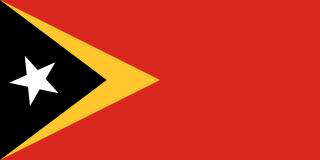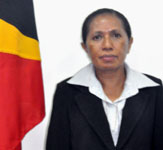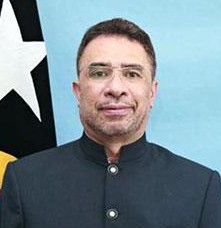
Timor is an island at the southern end of Maritime Southeast Asia, in the north of the Timor Sea. The island is divided between the sovereign states of East Timor on the eastern part and Indonesia on the western part. The Indonesian part, known as West Timor, constitutes part of the province of East Nusa Tenggara. Within West Timor lies an exclave of East Timor called Oecusse District. The island covers an area of 30,777 square kilometres. The name is a variant of timur, Malay for "east"; it is so called because it lies at the eastern end of the Lesser Sunda Islands. Mainland Australia is less than 500 km away, separated by the Timor Sea.

East Timor, officially the Democratic Republic of Timor-Leste, is a country in Southeast Asia and Oceania. The country comprises the eastern half of the island of Timor and the nearby islands of Atauro and Jaco. The first inhabitants are thought to be descendant of Australoid and Melanesian peoples. The Portuguese began to trade with Timor by the early 16th century and colonised it throughout the mid-century. Skirmishing with the Dutch in the region eventually resulted in an 1859 treaty for which Portugal ceded the western half of the island. Imperial Japan occupied East Timor during World War II, but Portugal resumed colonial authority after the Japanese surrender.

The political system in East Timor is a unitary semi-presidential representative democratic republic, whereby the Prime Minister of East Timor is the head of government and the President of East Timor functions as head of state. East Timor has a multi-party system. Executive power is exercised by the president and the government. Legislative power is vested in both the government and the National Parliament. The Judiciary is independent of the executive and the legislature. The East Timorese constitution was modelled on that of Portugal, with lesser power given to the president. The country is still in the process of building its administration and governmental institutions. The Economist Intelligence Unit rated East Timor a "flawed democracy" in 2022.

The Timor Leste Defence Force is the military of East Timor. The F-FDTL was established in February 2001 and comprises two infantry battalions, small naval and air components and several supporting units.
The Liquiçá Church massacre was a mass-killing that occurred in April 1999, during East Timor's bid for independence. It was the first case to be heard by the Second Special Panel.

Same is a town in the Same administrative post in the interior of East Timor, 81 kilometres (50 mi) south of Dili, the national capital. Same has a population of 7,413 and is the capital of Manufahi municipality, which was known as Same District in Portuguese Timor.

Aileu is the main township in Aileu District, East Timor. It is located 47 km (29 mi) southwest of Dili, the national capital, and had a population of 2,788 in 2015. In Portuguese Timor, the city was known as Vila General Carmona, after the Portuguese dictator António Óscar Carmona, but after World War II it was renamed. Aileu means "bent tree" in Mambai.

The Bunak people are an ethnic group that live in the mountainous region of central Timor, split between the political boundary between West Timor, Indonesia, particularly in Lamaknen District and East Timor. Their language is one of those on Timor which is not an Austronesian language, but rather a Papuan language, belonging to the Trans–New Guinea linguistic family. They are surrounded by groups which speak Malayo-Polynesian languages, like the Atoni and the Tetum.

The Armed Forces for the National Liberation of East Timor originally began as the military wing of the Fretilin party of East Timor. It was established on 20 August 1975 in response to Fretilin's political conflict with the Timorese Democratic Union (UDT).

José Maria de Vasconcelos, popularly known as Taur Matan Ruak, is an East Timorese politician who served as 8th prime minister of East Timor from 2018 to 2023. He also served as 5th president of East Timor from 2012 to 2017.

The Indonesian occupation of East Timor began in December 1975 and lasted until October 1999. After centuries of Portuguese colonial rule in East Timor, the 1974 Carnation Revolution in Portugal led to the decolonisation of its former colonies, creating instability in East Timor and leaving its future uncertain. After a small-scale civil war, the pro-independence Fretilin declared victory in the capital city of Dili and declared an independent East Timor on 28 November 1975.

East Timor, also known as Timor-Leste, officially the Democratic Republic of Timor-Leste, is a country in Southeast Asia. It comprises the eastern half of the island of Timor - of which the western half is administered by Indonesia - the exclave of Oecusse on the island's north-western half, and the minor islands of Atauro and Jaco. Australia is the country's southern neighbour, separated by the Timor Sea. The country's size is 14,950 square kilometres (5,770 sq mi). Dili - on the north coast of Timor - is its capital and largest city.
The East Timor and Indonesia Action Network (ETAN) is a nonprofit US organization supporting human rights throughout Southeast Asia and Oceania. ETAN was founded in 1991 to support the right to self-determination of Timor-Leste. In 1999, that goal was significantly realized when the people of East Timor voted for independence. Since then ETAN has focused on building on its success in support of justice and self-determination in Timor-Leste and the surrounding region.
Alas (East Timor) is a town in Alas Subdistrict. It is located in the interior of the island, 294 metres above sea level. As the crow flies, Alas is 56 km southeast of the state capital Dili und 7 km to the East of Same. Alas lies to the North of the Suco of Mahaquidan (Malaquidan, Malagidan), and the Alas suburbs of Uma Mean (Umanican, Umamean) and Beremanek are located in Mahaquidan. The suburbs of Lurin und Ailora are in the suco of Taitudac (Taitudak, Taitudac, Taitudal). It is located in the interior of the island, 294 metres above sea level. As the crow flies, Alas is 56 km southeast of the state capital Dili und 7 km to the East of Same. Alas lies to the North of the Suco of Mahaquidan (Malaquidan, Malagidan), and the Alas suburbs of Uma Mean (Umanican, Umamean) and Beremanek are located in Mahaquidan. The suburbs of Lurin und Ailora are in the suco of Taitudac (Taitudak, Taitudac, Taitudal). There is a medical station and a helicopter in Alas, as well as a primary school (Escola primaria Alas Vila) and a pre-secondary school.

The Santa Cruz massacre was the murder of at least 250 East Timorese pro-independence demonstrators in the Santa Cruz cemetery in the capital, Dili, on 12 November 1991, during the Indonesian occupation of East Timor and is part of the East Timor genocide.

The East Timor genocide refers to the "pacification campaigns" of state terrorism which were waged by the Indonesian New Order government during the Indonesian invasion and occupation of East Timor. The majority of sources consider the Indonesian killings in East Timor to constitute genocide, while other scholars disagree on certain aspects of the definition.

Babulo(Babolu) is a settlement in East Timor and a Suco in the Uato-Lari Administrative Post. The Suco is one of the ethnic centers of the Naueti, and is also inhabited by the Makasae, an ethnic minority in the region. The different groups and clans are tightly connected through an ancient social structure which still has a big impact on their society today.

Ilda Maria da Conceição, whose resistance names were Lalo Imin and Wairaha Gae Imin, is a politician from East Timor. She is a member of the FRETILIN party.
Anarchism in East Timor has its roots in the country's history as a penal colony, when many anarchists were deported there. The movement eventually evolved into an anti-colonial struggle against succeeding occupying powers: first the Portuguese Empire, then the Japanese Empire and the Indonesian New Order, before the country finally achieved independence in 2002.

Hernâni Filomena Maria Coelho da Silva, also known by his nom de guerreNatan, is an East Timorese politician and diplomat, and a member of the Fretilin political party. He has been the East Timorese Ambassador to both Australia and South Korea. Between February 2015 and September 2017, he was Minister of Foreign Affairs and Cooperation, and from October 2017 to June 2018 he was Minister of Petroleum.













